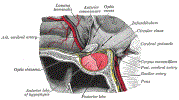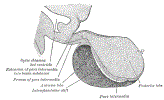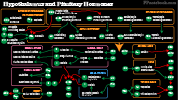II. Anatomy
- Pituitary Gland releases Hormones with long-lasting autonomic effects
- Anterior Pituitary
- Posterior Pituitary
- Releases Oxytocin and Vasopressin (ADH) produced in the Hypothalamus and stored in the posterior pituitary
- Images
 Lewis (1918) Gray's Anatomy 20th ed (in public domain at Yahoo or BartleBy)
Lewis (1918) Gray's Anatomy 20th ed (in public domain at Yahoo or BartleBy) Lewis (1918) Gray's Anatomy 20th ed (in public domain at Yahoo or BartleBy)
Lewis (1918) Gray's Anatomy 20th ed (in public domain at Yahoo or BartleBy) Lewis (1918) Gray's Anatomy 20th ed (in public domain at Yahoo or BartleBy)
Lewis (1918) Gray's Anatomy 20th ed (in public domain at Yahoo or BartleBy)
III. Anatomy: Cell types of Pituitary Gland
- Images
- Lactotrophs
- Gonadotrophs (Pituitary Gonadotropins)
- Luteinizing Hormone (LH) Secreting cells
- Follicle Stimulating Hormone (FSH) Secreting cells
- Somatotroph
- Growth HormoneSecreting cells (GH)
- Corticotroph
- Adrenocorticotropic Hormone (ACTH) Secreting cells
- Thyrotroph
- Thyroid Stimulating Hormone (TSH) Secreting cells
IV. Physiology: Pituitary Hormones
- See Hypothalamus
- Posterior Pituitary Gland (Hormones produced in the Hypothalamus, released from pituitary)
- Oxytocin
- Stimulates uterine contractions
- Stimulates milk let-down in Lactation
- Antidiuretic Hormone (ADH, Vasopressin)
- Increases renal water reaborption
- Oxytocin
- Anterior Pituitary Gland
- Prolactin
- Protein synthesized and secreted by Lactotrophs (acidophil cells) in the anterior pituitary
- Prolactin stimulates milk secretion into the Breast alveoli in pregnancy and Lactation
- Oxytocin stimulates myoepithelial cells to contract, expressing Breast Milk from the nipple
- Stimulated by Estrogen, vasoactive intestinal polypeptide (VIP), Thyroid Releasing Hormone (TRH)
- Inhibition by hypothalamic Dopamine (Prolactin Inhibiting Factor or PIF)
- Human Growth Hormone
- Polypeptide produced in the acidophil cells of the anterior pituitary
- Triggered by Hypoglycemia (or low Amino Acids) via hypothalamic release of GHRH
- Promotes bone and cartilage growth, Protein synthesis, glycogen storage, Fatty Acid increase
- Adrenocorticotropic Hormone (ACTH)
- Polypeptide synthesized and secreted by Basophil cells in the anterior pituitary
- Stimulation (releasing factors) include Corticotropin Releasing Hormone (CRH) and stress
- Inhibition by negative feedback loops (Cortisol inhibits CRH and ACTH release)
- ACTH stimulates the Adrenal Cortex to release Cortisol (and to a lesser extent Aldosterone and androgens)
- Thyroid Stimulating Hormone (TSH)
- See Thyroid Physiology
- Thyroid Stimulating Hormone (TSH) is a Glycoprotein synthesized in the Basophil cells of the anterior pituitary
- Stimulated by Thyroid Releasing Hormone (TRH)
- Inhibited by negative feedback from Thyroid Hormones (T4, T3)
- Thyroid Stimulating Hormone (TSH) promotes all aspects of Thyroid Hormone production
- Increases Iodide uptake and incorporation of Iodine into Thyroglobulin
- Increases lysis into active Thyroid Hormones T4 and T3
- Follicle Stimulating Hormone (FSH)
- FSH is a glyoprotein secreted by Basophil cells in the anterior Pituitary Gland
- Stimulation (releasing factors) is by Hypothalamic Gonadotrophic Releasing Hormone (GnRH)
- Inhibited via negative feedback loop by Testosterone, Estrogens, Progesterone and inhibin
- FSH stimulates ovarian follicle growth (which secretes Estradiol) in women
- FSH stimulates spermatogenesis and sperm maturation within Sertoli Cells in men
- Luteinizing Hormone (LH)
- LH is a Glycoprotein secreted by Basophil cells in the anterior Pituitary Gland
- Stimulation is by Hypothalamic Gonadotrophic Releasing Hormone (GnRH)
- Inhibited via negative feedback loop by Testosterone, Estrogens, Progesterone and inhibin
- LH stimulates ovarian follicles to ovulate and mature into a corpus luteum (produces Estrogen, Progesterone)
- LH stimulates Leydig Cells within Testes to produce Testosterone
- Prolactin
V. Physiology
- See Thyroid Physiology
- Regulation
- Positive Stimulation
- Thyroid Releasing Hormone (TRH, Thyrotopin Releasing Hormone, from Hypothalamus)
- Negative feedback
- Unbound Thyroxine (Free T4)
- Unbound Triiodothyronine (Free T3)
- Positive Stimulation
-
Thyroid Stimulating Hormone (TSH) promotes all aspects of Thyroid Hormone production
- Increases Iodide uptake
- Incorporation of Iodine into Thyroglobulin
- Thyroglobulin lysis into active Thyroid Hormones T4 and T3
- Stimulates proliferation of increased Thyroglobulin synthesizing cells (Cuboidal cells) in Thyroid follicles
- Variation
- TSH levels follow a circadian rhythm
- TSH will vary as much as 1-2 uIU/ml over the course of the day
- Consider drawing TSH at the same time of day for longterm serial measurements
- TSH levels increase with normal aging in euthyroid patients
- Consider using age-adjusted TSH interpretation
- Age 20-29: 3.56 mIU/ml is 97th percentile
- Age >80: 7.49 mIU/ml is 97th percentile
- Surks (2007) JCEM 92: 4575 [PubMed]
- Pregnancy
- See Thyroid Dysfunction in Pregnancy
- See Hypothyroidism in Pregnancy
- Maintaining euthyroid state in pregnancy is critical
- Euthyroid individuals still have considerable variation in TSH levels over time
- Populations of euthyroid individuals also have considerable variation in TSH levels
- TSH levels follow a circadian rhythm

